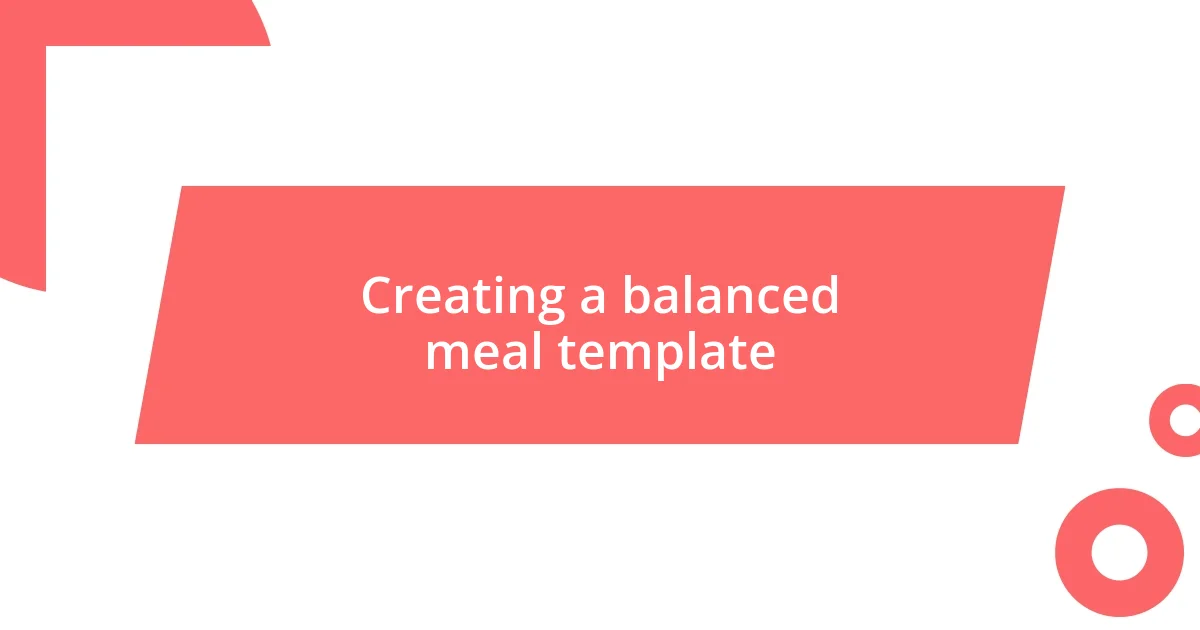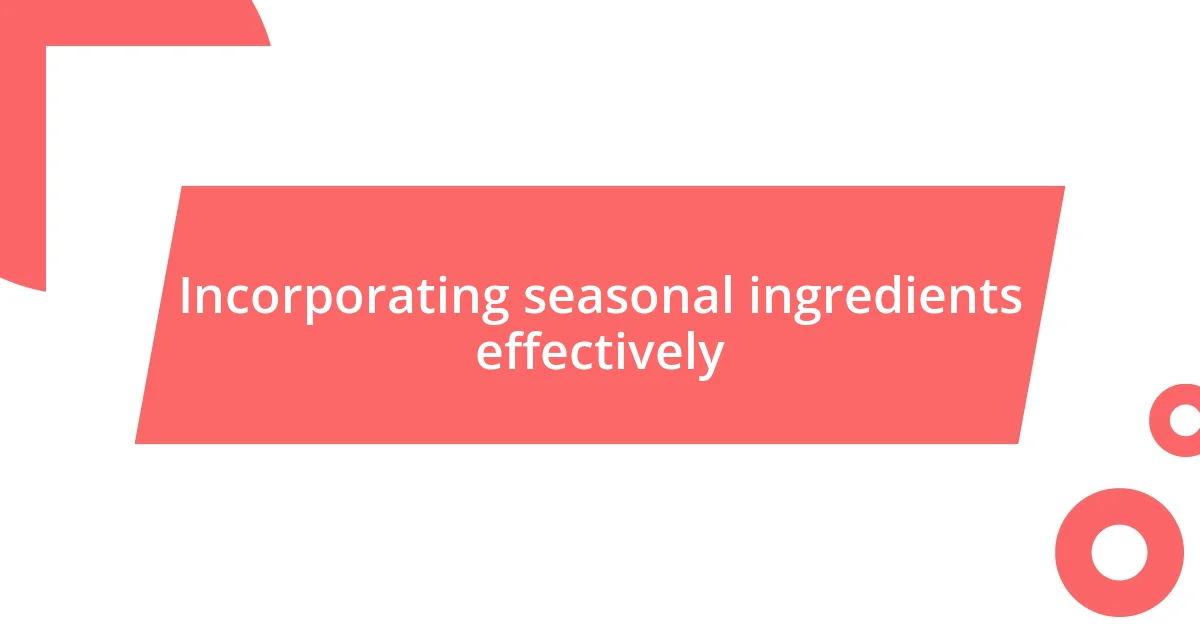Key takeaways:
- Meal planning saves time, reduces grocery expenses, and promotes healthier eating by allowing for a structured approach to meals.
- Setting clear meal planning goals, such as trying new recipes and focusing on nutrition, enhances the cooking experience and makes it more purposeful.
- Utilizing leftovers creatively and tracking progress enables efficient meal planning, minimizing waste and adapting to family preferences.

Understanding meal planning benefits
Meal planning has completely transformed how I approach my daily routine. One of the biggest benefits I’ve realized is the sheer amount of time it saves during the week. When I plan out my meals, those chaotic evenings where I scramble to figure out dinner become a distant memory. Isn’t it refreshing to know exactly what you’ll be cooking instead of standing in front of an open fridge, feeling overwhelmed?
Another significant advantage is the positive impact on my budget. By planning meals ahead, I can create a shopping list that focuses on specific ingredients instead of impulse buys. I still remember a time when I’d go grocery shopping and come home with a bunch of things I didn’t need. Now, I find myself saving money while still enjoying a variety of delicious meals throughout the week. Have you ever felt that pang of guilt when checking out at the grocery store? Meal planning has helped me avoid those awkward moments.
Moreover, meal planning encourages healthier eating habits. Since I take the time to incorporate a balance of nutrients and flavors in my meals, I end up making better food choices. I often reflect on how good it feels to nourish my body with wholesome ingredients rather than reaching for quick, unhealthy options. Doesn’t it feel empowering to cook something that fuels your body and feels good to eat?

Setting clear meal planning goals
Setting clear meal planning goals is crucial in transforming how I manage my kitchen. I’ve found that by pinpointing what I want to achieve with my meal planning, I save not only time but also mental energy. For instance, I set a goal to incorporate at least three new recipes each month—this keeps my meals exciting and helps me expand my culinary skills. It’s like a mini challenge that motivates me!
Here are some effective meal planning goals I often set for myself:
- Try new recipes: Aim for at least two new dishes each week.
- Focus on nutrition: Include a variety of fruits, vegetables, and whole grains in every meal.
- Maximize leftovers: Plan at least one meal per week that’s designed to use up leftovers efficiently.
- Target budget-friendly meals: Set a weekly budget that guides your ingredient choices.
- Streamline prep time: Reduce cooking time by prepping ingredients in advance on weekends.
By consciously setting these goals, each meal planning session feels purposeful and directed, rather than just a mundane chore. I remember the first time I mapped out a week’s worth of meals with clear objectives—it was exhilarating to see how organized I felt and how much smoother my week ran!

Creating a balanced meal template
Creating a balanced meal template has been a game-changer for me. By structuring my meals, I ensure that every plate includes a mix of proteins, carbohydrates, and healthy fats. This balance not only satisfies my hunger but also keeps my energy levels stable throughout the day. I can’t emphasize enough how that keeps me focused and productive—nothing derails my concentration like a heavy, unbalanced meal!
To illustrate this, I’ve developed a straightforward template that I can revisit weekly. For instance, I typically start with a lean protein, like grilled chicken or chickpeas, then add a complex carbohydrate, such as quinoa or sweet potatoes. Finally, I pile on the veggies to brighten my plate—broccoli, bell peppers, or even leafy greens. This combination not only nourishes my body but also brings a burst of color and flavor that I genuinely look forward to. Have you experienced the excitement of plating a colorful dish? It definitely elevates the whole dining experience!
One essential trick I’ve discovered is keeping a list of preferred ingredients on hand. This way, I can quickly assemble meals that fit my template without thinking too hard about it. I often find myself tossing together whatever is fresh in my fridge with a bit of oil and seasoning. It’s liberating to know that, no matter what, I can whip up something nutritious without any fuss. Here’s a simple comparison of my meal template approach:
| Element | Example |
|---|---|
| Protein | Grilled chicken |
| Complex Carb | Quinoa |
| Vegetable | Steamed broccoli |
| Healthy Fat | Avocado slices |

Incorporating seasonal ingredients effectively
Incorporating seasonal ingredients effectively has transformed my approach to meal planning. Each season brings its own bounty, allowing me to connect with nature and enjoy flavors at their peak. I remember the first time I decided to base a week’s meals around farmers’ market finds—it was thrilling to explore what was fresh and let that guide my cooking. Have you ever tasted a ripe, summer tomato straight from the vine? There’s nothing quite like it, and it inspires creativity in the kitchen.
I’ve found that keeping a seasonal calendar handy is a practical tool. This simple guide helps me stay aware of what’s in season and encourages me to mix things up. For example, in fall, I love roasting butternut squash alongside autumn greens and hearty grains. It’s like bringing the essence of the season onto my plate. When I sit down to enjoy these meals, I not only relish the flavors but also feel a connection to the changing world around me. It’s comforting to know that I’m supporting local farmers while nourishing my body.
When I meal plan, I challenge myself to create at least one dish each week using whatever seasonal ingredient catches my eye. The other day, I made a lemon-zucchini pasta that was nothing short of a summer celebration. The mingling of fresh herbs and crisp zucchini made me feel invigorated, almost as if I could see the sunshine in each bite! How do you feel about using seasonal produce? For me, it’s more than just an ingredient choice; it’s an opportunity to embrace the cycles of nature and make eating an adventurous journey.

Utilizing leftovers for efficiency
One of my favorite strategies for utilizing leftovers is to think of them as building blocks for future meals. For instance, if I grilled chicken for dinner, I’ll set aside some extra to toss into a salad or stir into a soup the next day. It feels rewarding to see that one cooking effort stretch over multiple meals, reducing waste and saving time. Have you ever realized how satisfying it is to reinvent a dish with just a few tweaks? It’s like giving yesterday’s meal a fresh personality!
I also love to have a designated day for using up leftovers, which I fondly call “Clean-Out-the-Fridge Night.” On that evening, I’ll dig out whatever is lurking in the fridge—odds and ends of veggies, half-used sauces, and those mysterious containers from last week’s takeout. I often blend these ingredients to make a frittata or a hearty grain bowl, and it’s amazing how creativity can transform what could have been forgotten into something delicious and new. Isn’t it fascinating how leftovers can inspire culinary creativity, making my meal planning both efficient and fun?
What keeps me motivated is the idea that utilizing leftovers doesn’t just help my kitchen organization; it also sparks joy. Each time I concoct something new from yesterday’s fare, it feels like a mini adventure. I often think about how many dishes I’ve crafted from leftover roasted veggies—sometimes, those very dishes turn out to be my favorites! Have you experienced that thrill of turning what’s in your fridge into something completely unique? It’s one of those little joys that makes home cooking truly rewarding.

Tracking progress and making adjustments
Tracking my progress in meal planning has become an essential part of my culinary journey. I keep a simple food journal to jot down what works and what doesn’t, which helps me stay on track. Last week, I realized that my family craved lighter meals due to the unseasonably warm weather, so I quickly adjusted by swapping out heavier dishes for vibrant salads and grilled proteins. Isn’t it amazing how a small tweak can make a meal plan feel fresh and in tune with our needs?
I also pay attention to the feedback from my family. When I tried a new spicy chili recipe that had everyone reaching for water, it was crucial to note that some flavors might need dialing back. I like to label the dishes by their popularity in the fridge—my kids have their favorites, and seeing them finished in record time tells me what to repeat. Have you ever experienced the thrill of seeing a dish vanish in minutes? It’s like a little victory that guides my future planning.
Adjusting my meal plans based on progress feels empowering. When I notice that a particular ingredient is consistently leftover, it pushes me to get creative. Just last month, I had too many bell peppers on hand, so instead of letting them go limp in the fridge, I made a batch of stuffed peppers for dinner and froze extras for busy nights. That adaptability not only reduces waste but also makes me feel like an informed chef steering my kitchen with purpose. How do you adapt your meal planning when things don’t go as expected? It’s all about finding that perfect balance.













